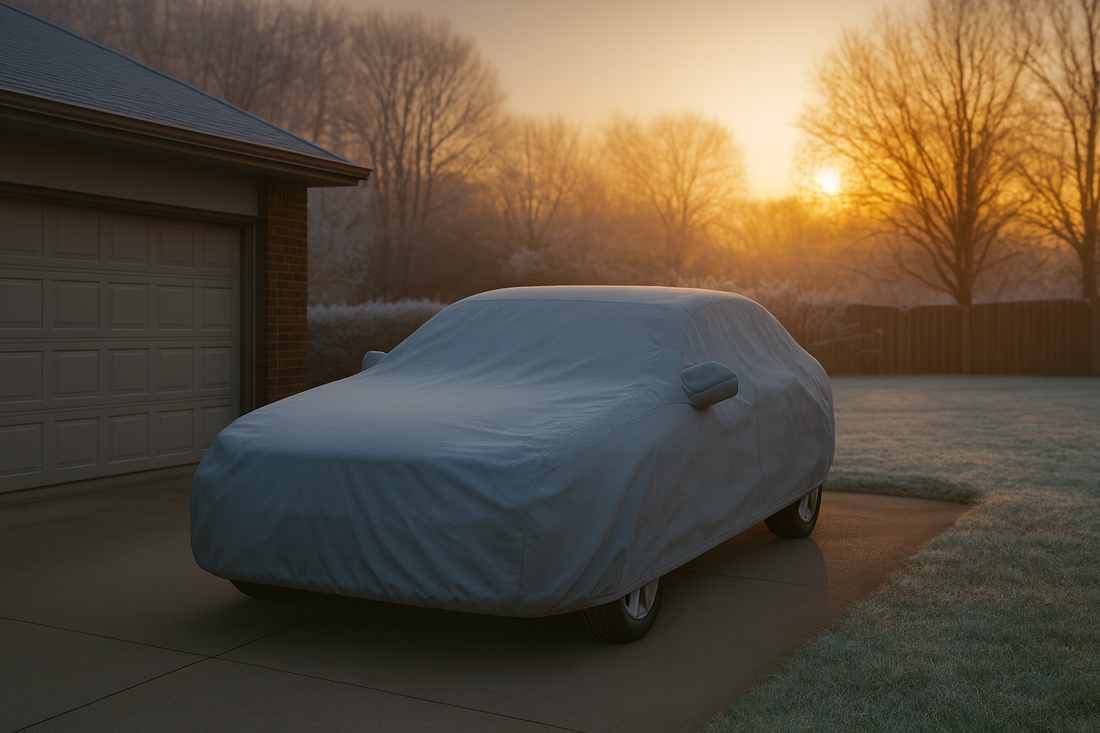Why “before the first freeze” matters
That first hard freeze isn’t just cold—it’s the point when plasticizers in trim stiffen, rubber seals lose elasticity, and micro-scratches in paint can wick moisture that freezes and expands. If your vehicle sits outside overnight, you’ll also battle frost and sheet ice on glass most mornings. A properly fitted car cover for winter prevents frost from forming directly on the glass and shields paint and trim from repeated freeze–thaw stress.
Fast morning starts
A breathable, water-resistant cover keeps dew and frost from bonding to glass. Pull the cover, shake it out, and you’re driving—no scraping that risks gouging wiper blades or scratching the windshield.
What winter really throws at your vehicle
-
Freeze–thaw cycles: Expansion in clearcoat micro-swirls, stress on badges, trim, and seals.
-
Winter sun (yes, UV still bites): Low-angle sun + reflective snow amplifies UV exposure, fading dashboards and drying wiper plastics.
-
Wind + grit: Cold fronts carry abrasive dust and salt crystals that act like sandpaper.
-
Road salt & brine mist: Corrosive residue gets everywhere—hood, fenders, and glass.
The right cover for the job (quick picks)
-
Daily-driver outdoors (snow, wind, grit): BestFit® All-Weather HD — heavy-duty, water-resistant shell with a soft, anti-scratch liner for paint. Great in gusty conditions with reinforced tie-downs.
-
Mixed sun + cold, lighter precipitation: BestFit® SunGuard — breathable and UV-focused, ideal where winter is cold but not relentlessly wet.
-
Garage or carport, dust control: BestFit® Basic — lightweight indoor protection; use outdoors only short-term or under cover.
Not sure which to pick? Choose by where the car sleeps (street/driveway vs. garage) and your average winter pattern (snowy/wet vs. cold/clear).
Fabric features that matter in winter (and what to ignore)
Must-have:
-
Breathability: Lets trapped moisture escape so you don’t get condensation or a clammy underside that freezes.
-
Securement system: Integrated straps/hem elastic + grommets to stop the “parachute” effect in wind.
-
Soft liner: Fleece or brushed inner face to reduce micro-marring on cold, brittle clearcoats.
-
True fitment: A cover that fits your body style and length stays put and protects better.
Skip the myths:
-
100% waterproof = best. In winter, a balanced water-resistant + breathable cover usually performs better than a plastic tarp that traps condensation.
Setup for winter success (5-minute routine)
-
Wash & dry the car (quick rinse or waterless detail). Dirt is abrasive under a cover.
-
Inspect seals & blades. Replace cracked wipers now; they’ll survive winter better under a cover.
-
Fit the cover nose-to-tail. Hook front corners, pull across the roof, then rear corners.
-
Secure straps/grommets. Cross underbody straps if windy; add a cable lock if street-parked.
-
Morning removal. Pull forward to the hood, shake, fold loosely. Do not store soaking wet—hang to dry if needed.
Common winter scenarios & what to use
-
Heavy overnight frost; occasional snow: All-Weather HD to prevent freeze-bond on glass; remove and go.
-
Bright but cold days (high UV index on snow): SunGuard to protect dash, plastics, and paint from UV without trapping moisture.
-
Apartment/curb parking with wind tunnels: All-Weather HD + strap kit; consider a cable lock.
-
Garage queen in a cold garage: Basic for dust + accidental rub protection; no need for heavy shells.
FAQs
Will a winter cover scratch my paint?
Not when it fits right, you use a soft-lined option, and keep the paint reasonably clean. Grit is the enemy—quick rinses help.
Do I still need to warm up the car?
Modern fuel-injected engines don’t require long idles. A cover saves time by reducing scraping; drive gently for the first few minutes.
What about hail?
A cover won’t stop large hail, but a heavier, padded option plus moving under a carport or overhang provides the best practical protection.

